Tort of Negligence and Duty of Care: A Legal Analysis of Liability
VerifiedAdded on 2023/01/11
|8
|1933
|54
Essay
AI Summary
This essay provides a comprehensive overview of the tort of negligence and the concept of duty of care, examining the legal principles and their practical application. It begins with a definition of negligence and duty of care, highlighting the factors that contribute to establishing a breach of duty. The essay then explores the liability of Extortionate PLC in a scenario involving a customer's injury, analyzing the potential legal claims and defenses. It delves into the doctrine of tort, emphasizing the company's responsibilities and ethical considerations. Furthermore, the essay presents real-world examples and case studies, such as the Liebeck v. McDonald's case, to illustrate the consequences of negligence. The analysis also covers ethical considerations for Extortionate PLC, possible defenses, and the importance of adhering to ethical codes of conduct to avoid lawsuits and maintain customer trust. The essay concludes by summarizing the key findings and emphasizing the significance of ethical practices and legal compliance in business operations.
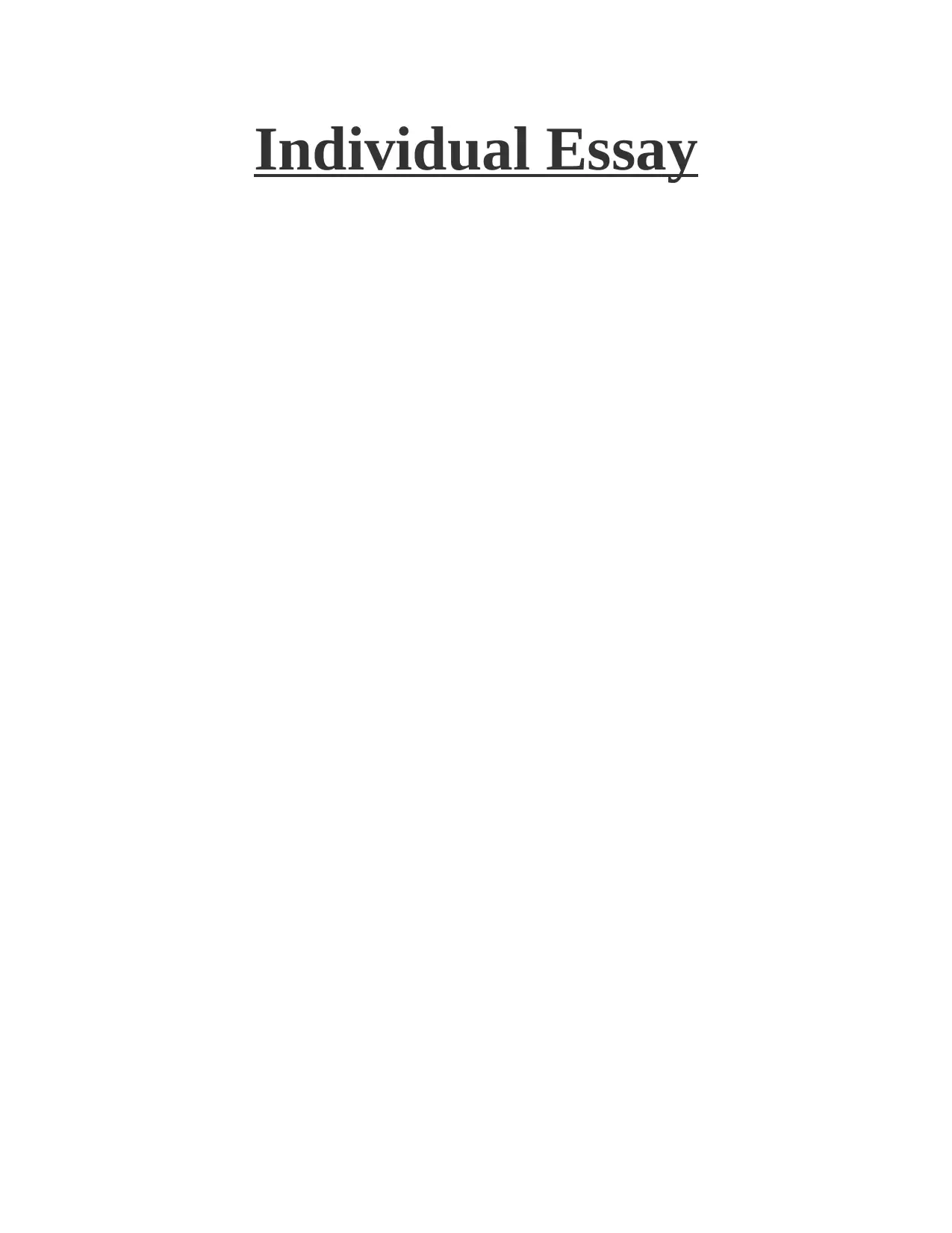
Individual Essay
Paraphrase This Document
Need a fresh take? Get an instant paraphrase of this document with our AI Paraphraser
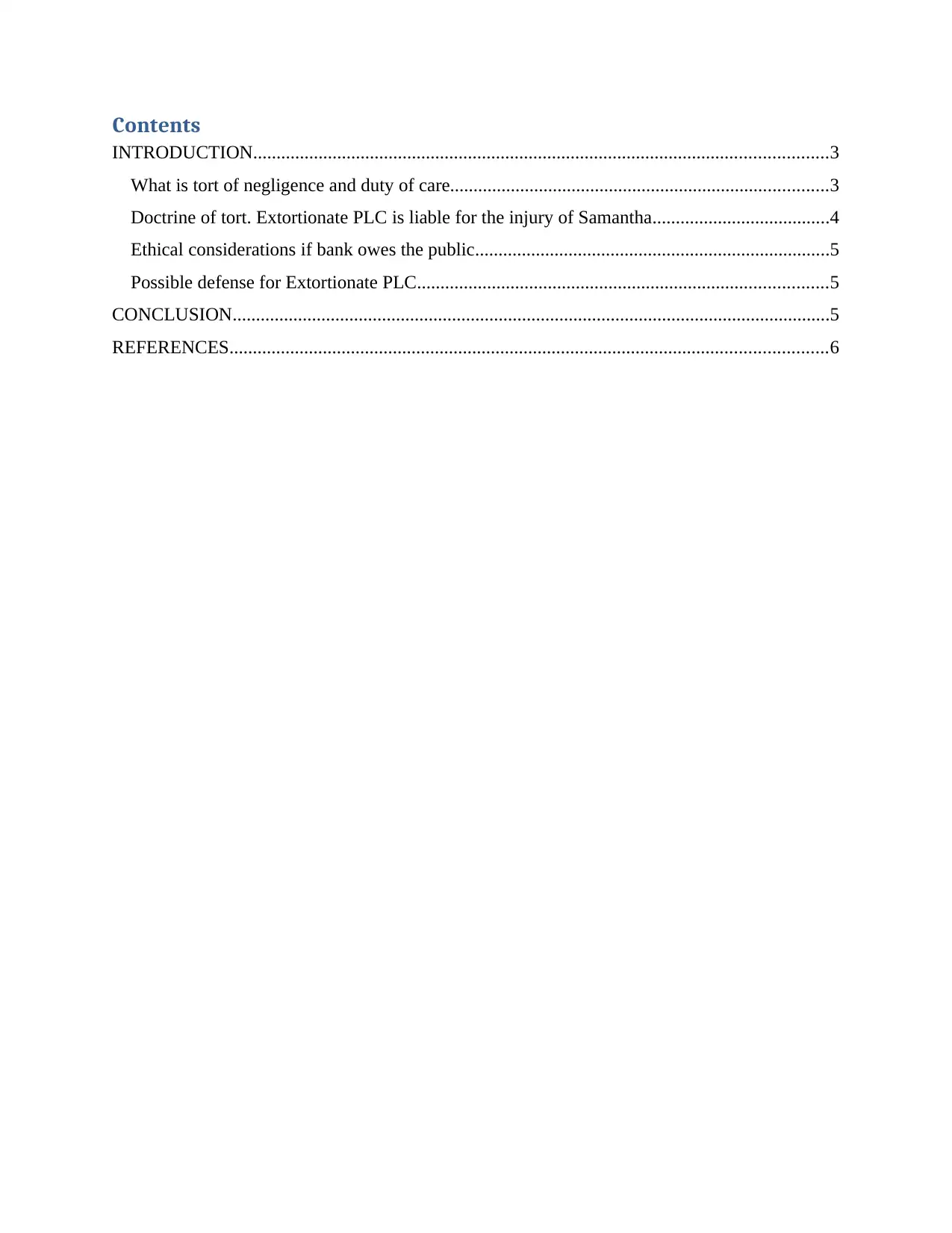
Contents
INTRODUCTION...........................................................................................................................3
What is tort of negligence and duty of care.................................................................................3
Doctrine of tort. Extortionate PLC is liable for the injury of Samantha......................................4
Ethical considerations if bank owes the public............................................................................5
Possible defense for Extortionate PLC........................................................................................5
CONCLUSION................................................................................................................................5
REFERENCES................................................................................................................................6
INTRODUCTION...........................................................................................................................3
What is tort of negligence and duty of care.................................................................................3
Doctrine of tort. Extortionate PLC is liable for the injury of Samantha......................................4
Ethical considerations if bank owes the public............................................................................5
Possible defense for Extortionate PLC........................................................................................5
CONCLUSION................................................................................................................................5
REFERENCES................................................................................................................................6
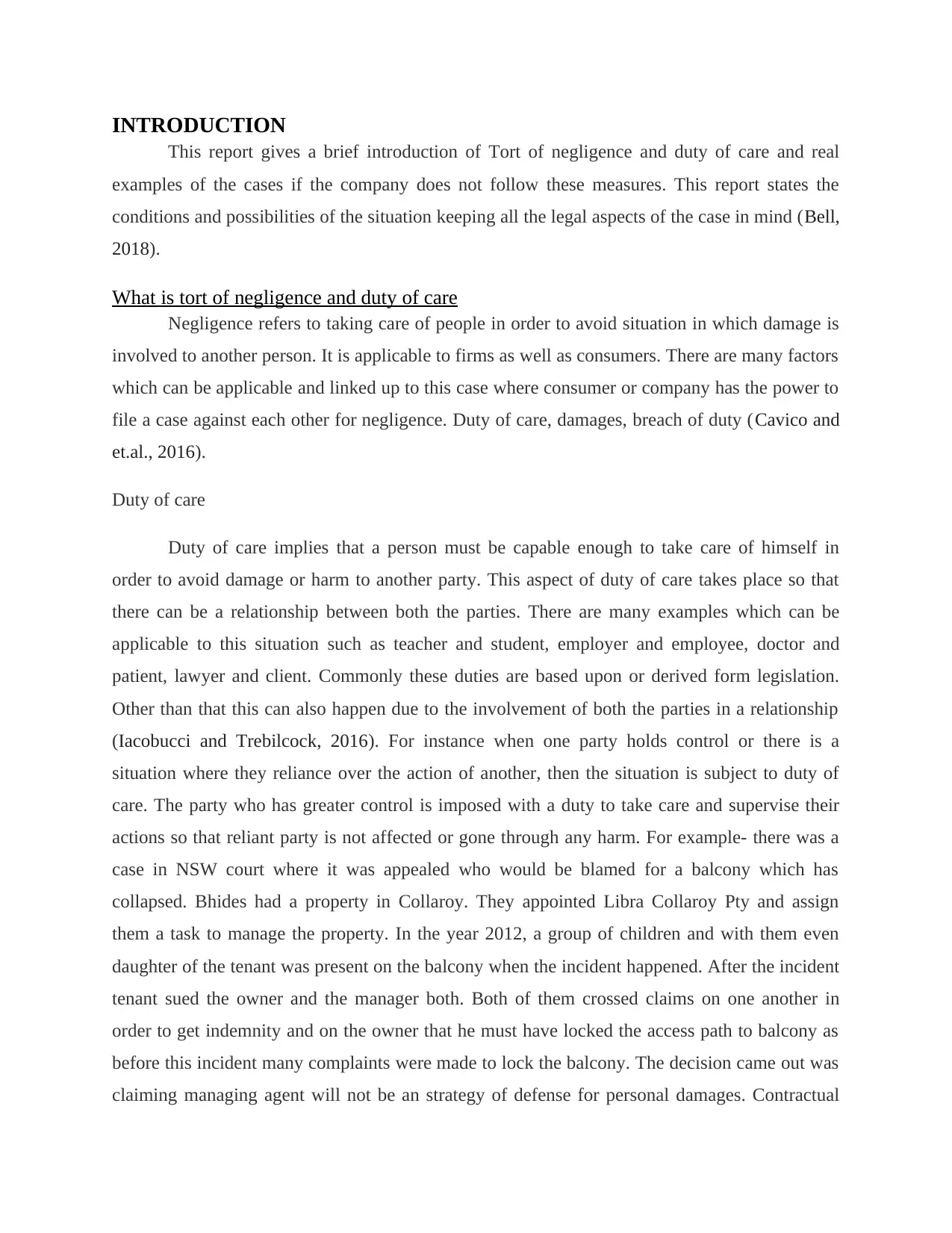
INTRODUCTION
This report gives a brief introduction of Tort of negligence and duty of care and real
examples of the cases if the company does not follow these measures. This report states the
conditions and possibilities of the situation keeping all the legal aspects of the case in mind (Bell,
2018).
What is tort of negligence and duty of care
Negligence refers to taking care of people in order to avoid situation in which damage is
involved to another person. It is applicable to firms as well as consumers. There are many factors
which can be applicable and linked up to this case where consumer or company has the power to
file a case against each other for negligence. Duty of care, damages, breach of duty (Cavico and
et.al., 2016).
Duty of care
Duty of care implies that a person must be capable enough to take care of himself in
order to avoid damage or harm to another party. This aspect of duty of care takes place so that
there can be a relationship between both the parties. There are many examples which can be
applicable to this situation such as teacher and student, employer and employee, doctor and
patient, lawyer and client. Commonly these duties are based upon or derived form legislation.
Other than that this can also happen due to the involvement of both the parties in a relationship
(Iacobucci and Trebilcock, 2016). For instance when one party holds control or there is a
situation where they reliance over the action of another, then the situation is subject to duty of
care. The party who has greater control is imposed with a duty to take care and supervise their
actions so that reliant party is not affected or gone through any harm. For example- there was a
case in NSW court where it was appealed who would be blamed for a balcony which has
collapsed. Bhides had a property in Collaroy. They appointed Libra Collaroy Pty and assign
them a task to manage the property. In the year 2012, a group of children and with them even
daughter of the tenant was present on the balcony when the incident happened. After the incident
tenant sued the owner and the manager both. Both of them crossed claims on one another in
order to get indemnity and on the owner that he must have locked the access path to balcony as
before this incident many complaints were made to lock the balcony. The decision came out was
claiming managing agent will not be an strategy of defense for personal damages. Contractual
This report gives a brief introduction of Tort of negligence and duty of care and real
examples of the cases if the company does not follow these measures. This report states the
conditions and possibilities of the situation keeping all the legal aspects of the case in mind (Bell,
2018).
What is tort of negligence and duty of care
Negligence refers to taking care of people in order to avoid situation in which damage is
involved to another person. It is applicable to firms as well as consumers. There are many factors
which can be applicable and linked up to this case where consumer or company has the power to
file a case against each other for negligence. Duty of care, damages, breach of duty (Cavico and
et.al., 2016).
Duty of care
Duty of care implies that a person must be capable enough to take care of himself in
order to avoid damage or harm to another party. This aspect of duty of care takes place so that
there can be a relationship between both the parties. There are many examples which can be
applicable to this situation such as teacher and student, employer and employee, doctor and
patient, lawyer and client. Commonly these duties are based upon or derived form legislation.
Other than that this can also happen due to the involvement of both the parties in a relationship
(Iacobucci and Trebilcock, 2016). For instance when one party holds control or there is a
situation where they reliance over the action of another, then the situation is subject to duty of
care. The party who has greater control is imposed with a duty to take care and supervise their
actions so that reliant party is not affected or gone through any harm. For example- there was a
case in NSW court where it was appealed who would be blamed for a balcony which has
collapsed. Bhides had a property in Collaroy. They appointed Libra Collaroy Pty and assign
them a task to manage the property. In the year 2012, a group of children and with them even
daughter of the tenant was present on the balcony when the incident happened. After the incident
tenant sued the owner and the manager both. Both of them crossed claims on one another in
order to get indemnity and on the owner that he must have locked the access path to balcony as
before this incident many complaints were made to lock the balcony. The decision came out was
claiming managing agent will not be an strategy of defense for personal damages. Contractual
⊘ This is a preview!⊘
Do you want full access?
Subscribe today to unlock all pages.

Trusted by 1+ million students worldwide
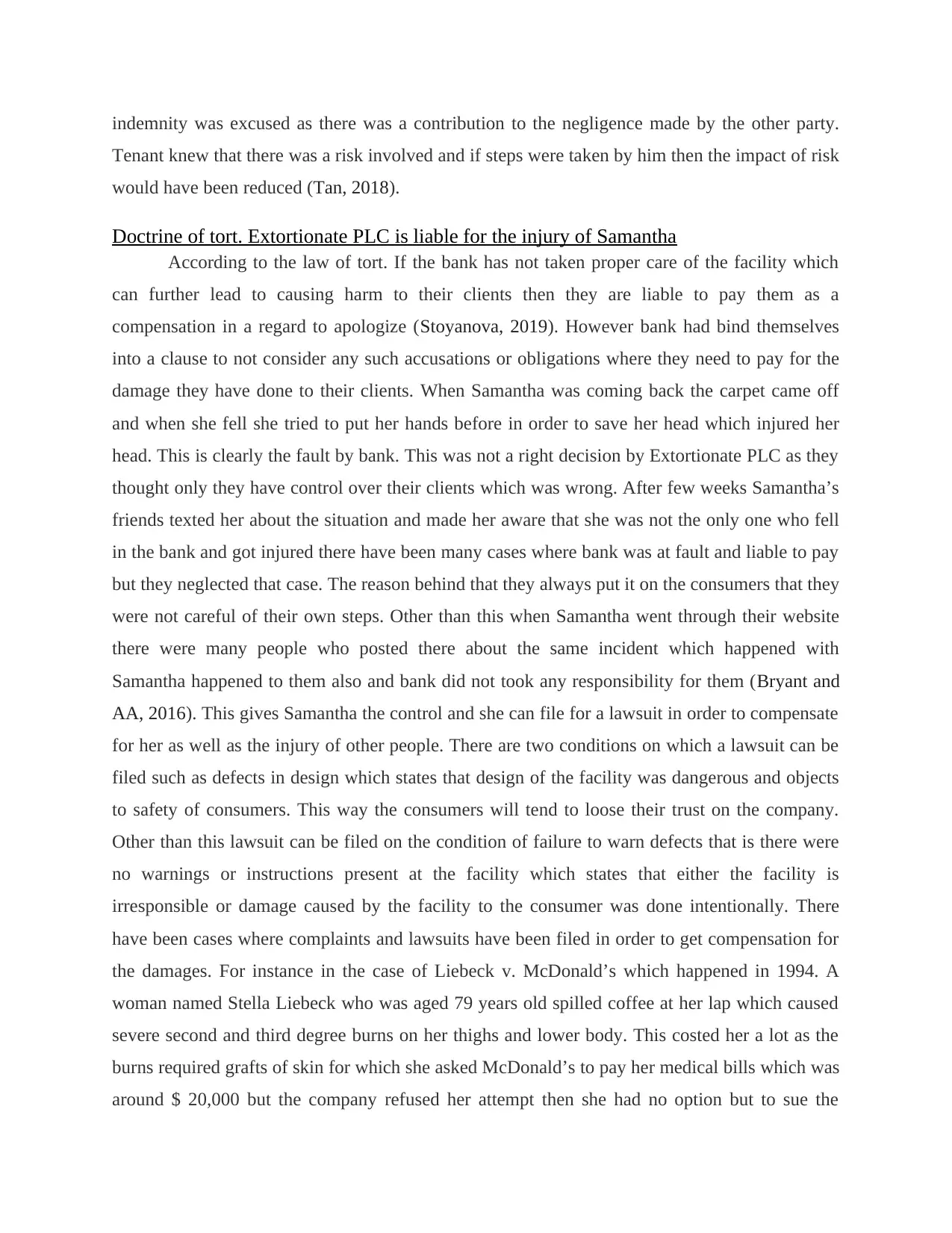
indemnity was excused as there was a contribution to the negligence made by the other party.
Tenant knew that there was a risk involved and if steps were taken by him then the impact of risk
would have been reduced (Tan, 2018).
Doctrine of tort. Extortionate PLC is liable for the injury of Samantha
According to the law of tort. If the bank has not taken proper care of the facility which
can further lead to causing harm to their clients then they are liable to pay them as a
compensation in a regard to apologize (Stoyanova, 2019). However bank had bind themselves
into a clause to not consider any such accusations or obligations where they need to pay for the
damage they have done to their clients. When Samantha was coming back the carpet came off
and when she fell she tried to put her hands before in order to save her head which injured her
head. This is clearly the fault by bank. This was not a right decision by Extortionate PLC as they
thought only they have control over their clients which was wrong. After few weeks Samantha’s
friends texted her about the situation and made her aware that she was not the only one who fell
in the bank and got injured there have been many cases where bank was at fault and liable to pay
but they neglected that case. The reason behind that they always put it on the consumers that they
were not careful of their own steps. Other than this when Samantha went through their website
there were many people who posted there about the same incident which happened with
Samantha happened to them also and bank did not took any responsibility for them (Bryant and
AA, 2016). This gives Samantha the control and she can file for a lawsuit in order to compensate
for her as well as the injury of other people. There are two conditions on which a lawsuit can be
filed such as defects in design which states that design of the facility was dangerous and objects
to safety of consumers. This way the consumers will tend to loose their trust on the company.
Other than this lawsuit can be filed on the condition of failure to warn defects that is there were
no warnings or instructions present at the facility which states that either the facility is
irresponsible or damage caused by the facility to the consumer was done intentionally. There
have been cases where complaints and lawsuits have been filed in order to get compensation for
the damages. For instance in the case of Liebeck v. McDonald’s which happened in 1994. A
woman named Stella Liebeck who was aged 79 years old spilled coffee at her lap which caused
severe second and third degree burns on her thighs and lower body. This costed her a lot as the
burns required grafts of skin for which she asked McDonald’s to pay her medical bills which was
around $ 20,000 but the company refused her attempt then she had no option but to sue the
Tenant knew that there was a risk involved and if steps were taken by him then the impact of risk
would have been reduced (Tan, 2018).
Doctrine of tort. Extortionate PLC is liable for the injury of Samantha
According to the law of tort. If the bank has not taken proper care of the facility which
can further lead to causing harm to their clients then they are liable to pay them as a
compensation in a regard to apologize (Stoyanova, 2019). However bank had bind themselves
into a clause to not consider any such accusations or obligations where they need to pay for the
damage they have done to their clients. When Samantha was coming back the carpet came off
and when she fell she tried to put her hands before in order to save her head which injured her
head. This is clearly the fault by bank. This was not a right decision by Extortionate PLC as they
thought only they have control over their clients which was wrong. After few weeks Samantha’s
friends texted her about the situation and made her aware that she was not the only one who fell
in the bank and got injured there have been many cases where bank was at fault and liable to pay
but they neglected that case. The reason behind that they always put it on the consumers that they
were not careful of their own steps. Other than this when Samantha went through their website
there were many people who posted there about the same incident which happened with
Samantha happened to them also and bank did not took any responsibility for them (Bryant and
AA, 2016). This gives Samantha the control and she can file for a lawsuit in order to compensate
for her as well as the injury of other people. There are two conditions on which a lawsuit can be
filed such as defects in design which states that design of the facility was dangerous and objects
to safety of consumers. This way the consumers will tend to loose their trust on the company.
Other than this lawsuit can be filed on the condition of failure to warn defects that is there were
no warnings or instructions present at the facility which states that either the facility is
irresponsible or damage caused by the facility to the consumer was done intentionally. There
have been cases where complaints and lawsuits have been filed in order to get compensation for
the damages. For instance in the case of Liebeck v. McDonald’s which happened in 1994. A
woman named Stella Liebeck who was aged 79 years old spilled coffee at her lap which caused
severe second and third degree burns on her thighs and lower body. This costed her a lot as the
burns required grafts of skin for which she asked McDonald’s to pay her medical bills which was
around $ 20,000 but the company refused her attempt then she had no option but to sue the
Paraphrase This Document
Need a fresh take? Get an instant paraphrase of this document with our AI Paraphraser
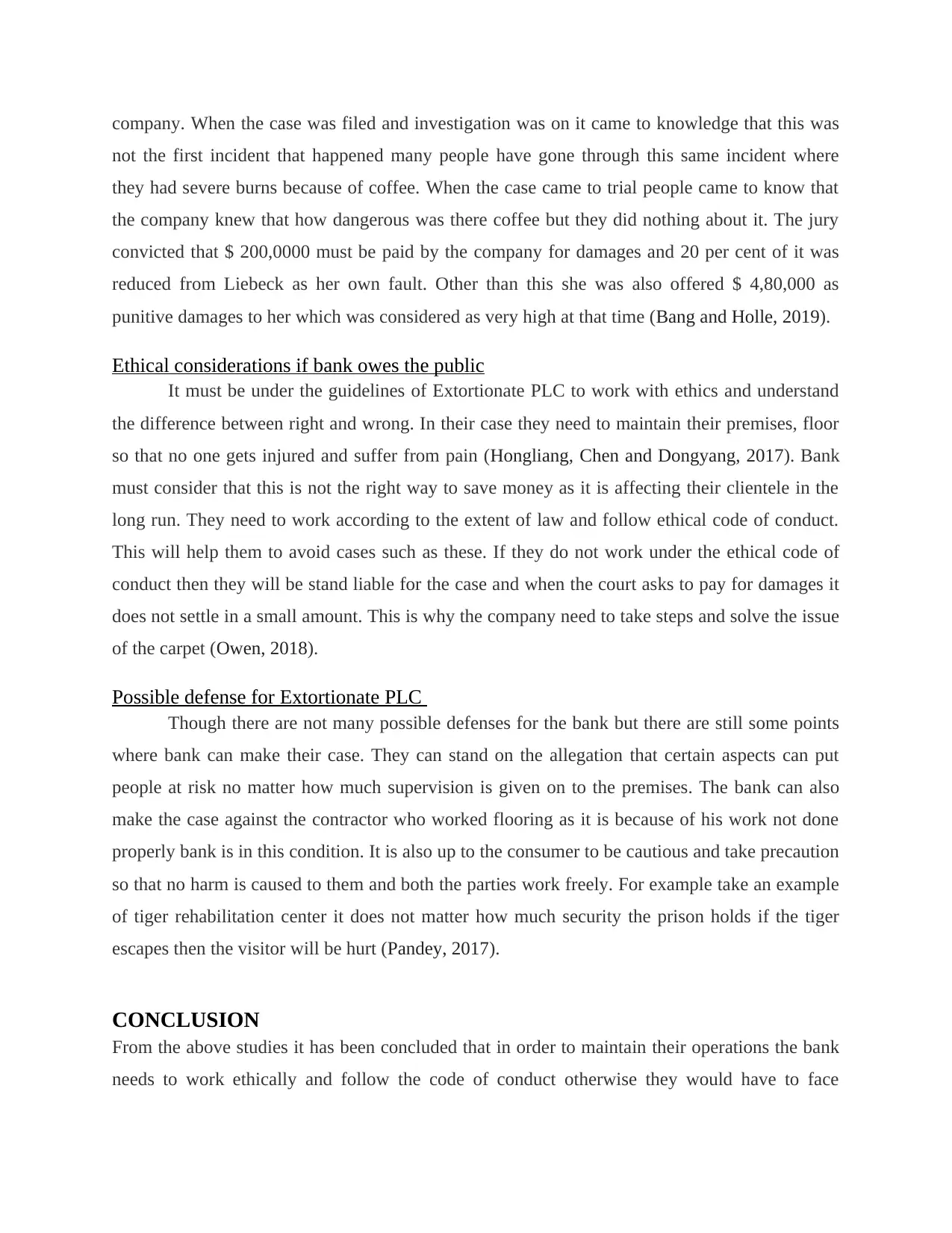
company. When the case was filed and investigation was on it came to knowledge that this was
not the first incident that happened many people have gone through this same incident where
they had severe burns because of coffee. When the case came to trial people came to know that
the company knew that how dangerous was there coffee but they did nothing about it. The jury
convicted that $ 200,0000 must be paid by the company for damages and 20 per cent of it was
reduced from Liebeck as her own fault. Other than this she was also offered $ 4,80,000 as
punitive damages to her which was considered as very high at that time (Bang and Holle, 2019).
Ethical considerations if bank owes the public
It must be under the guidelines of Extortionate PLC to work with ethics and understand
the difference between right and wrong. In their case they need to maintain their premises, floor
so that no one gets injured and suffer from pain (Hongliang, Chen and Dongyang, 2017). Bank
must consider that this is not the right way to save money as it is affecting their clientele in the
long run. They need to work according to the extent of law and follow ethical code of conduct.
This will help them to avoid cases such as these. If they do not work under the ethical code of
conduct then they will be stand liable for the case and when the court asks to pay for damages it
does not settle in a small amount. This is why the company need to take steps and solve the issue
of the carpet (Owen, 2018).
Possible defense for Extortionate PLC
Though there are not many possible defenses for the bank but there are still some points
where bank can make their case. They can stand on the allegation that certain aspects can put
people at risk no matter how much supervision is given on to the premises. The bank can also
make the case against the contractor who worked flooring as it is because of his work not done
properly bank is in this condition. It is also up to the consumer to be cautious and take precaution
so that no harm is caused to them and both the parties work freely. For example take an example
of tiger rehabilitation center it does not matter how much security the prison holds if the tiger
escapes then the visitor will be hurt (Pandey, 2017).
CONCLUSION
From the above studies it has been concluded that in order to maintain their operations the bank
needs to work ethically and follow the code of conduct otherwise they would have to face
not the first incident that happened many people have gone through this same incident where
they had severe burns because of coffee. When the case came to trial people came to know that
the company knew that how dangerous was there coffee but they did nothing about it. The jury
convicted that $ 200,0000 must be paid by the company for damages and 20 per cent of it was
reduced from Liebeck as her own fault. Other than this she was also offered $ 4,80,000 as
punitive damages to her which was considered as very high at that time (Bang and Holle, 2019).
Ethical considerations if bank owes the public
It must be under the guidelines of Extortionate PLC to work with ethics and understand
the difference between right and wrong. In their case they need to maintain their premises, floor
so that no one gets injured and suffer from pain (Hongliang, Chen and Dongyang, 2017). Bank
must consider that this is not the right way to save money as it is affecting their clientele in the
long run. They need to work according to the extent of law and follow ethical code of conduct.
This will help them to avoid cases such as these. If they do not work under the ethical code of
conduct then they will be stand liable for the case and when the court asks to pay for damages it
does not settle in a small amount. This is why the company need to take steps and solve the issue
of the carpet (Owen, 2018).
Possible defense for Extortionate PLC
Though there are not many possible defenses for the bank but there are still some points
where bank can make their case. They can stand on the allegation that certain aspects can put
people at risk no matter how much supervision is given on to the premises. The bank can also
make the case against the contractor who worked flooring as it is because of his work not done
properly bank is in this condition. It is also up to the consumer to be cautious and take precaution
so that no harm is caused to them and both the parties work freely. For example take an example
of tiger rehabilitation center it does not matter how much security the prison holds if the tiger
escapes then the visitor will be hurt (Pandey, 2017).
CONCLUSION
From the above studies it has been concluded that in order to maintain their operations the bank
needs to work ethically and follow the code of conduct otherwise they would have to face
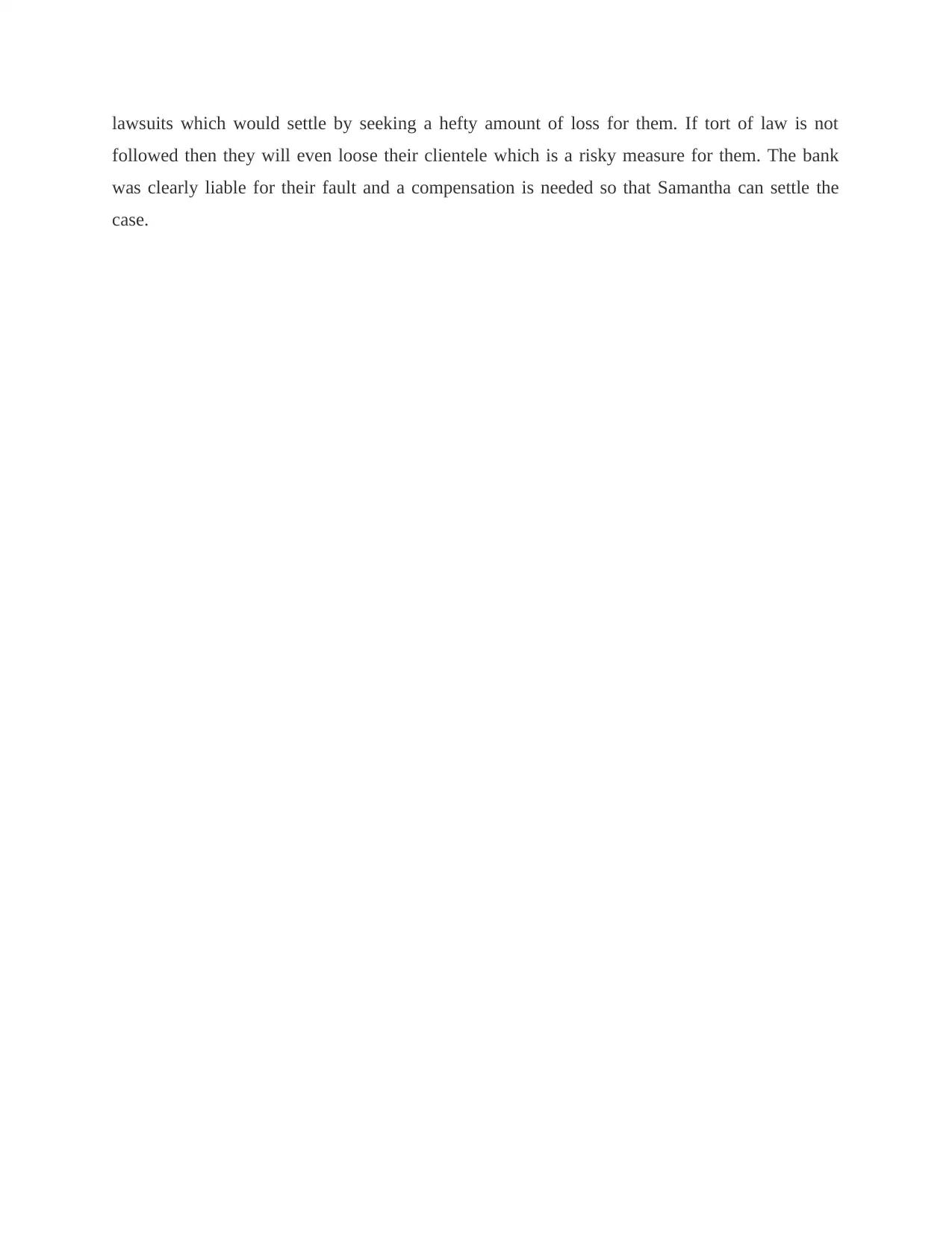
lawsuits which would settle by seeking a hefty amount of loss for them. If tort of law is not
followed then they will even loose their clientele which is a risky measure for them. The bank
was clearly liable for their fault and a compensation is needed so that Samantha can settle the
case.
followed then they will even loose their clientele which is a risky measure for them. The bank
was clearly liable for their fault and a compensation is needed so that Samantha can settle the
case.
⊘ This is a preview!⊘
Do you want full access?
Subscribe today to unlock all pages.

Trusted by 1+ million students worldwide

Paraphrase This Document
Need a fresh take? Get an instant paraphrase of this document with our AI Paraphraser
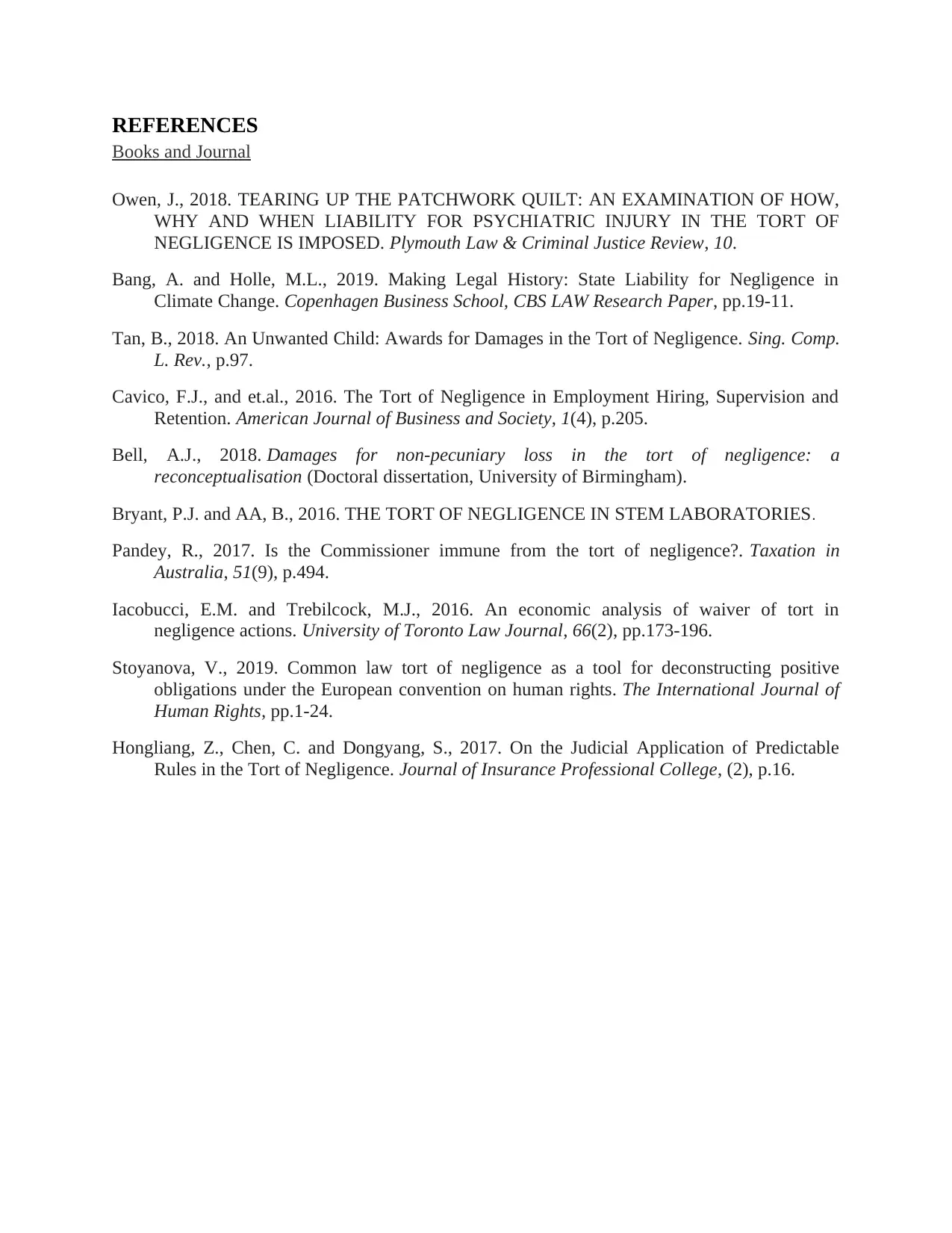
REFERENCES
Books and Journal
Owen, J., 2018. TEARING UP THE PATCHWORK QUILT: AN EXAMINATION OF HOW,
WHY AND WHEN LIABILITY FOR PSYCHIATRIC INJURY IN THE TORT OF
NEGLIGENCE IS IMPOSED. Plymouth Law & Criminal Justice Review, 10.
Bang, A. and Holle, M.L., 2019. Making Legal History: State Liability for Negligence in
Climate Change. Copenhagen Business School, CBS LAW Research Paper, pp.19-11.
Tan, B., 2018. An Unwanted Child: Awards for Damages in the Tort of Negligence. Sing. Comp.
L. Rev., p.97.
Cavico, F.J., and et.al., 2016. The Tort of Negligence in Employment Hiring, Supervision and
Retention. American Journal of Business and Society, 1(4), p.205.
Bell, A.J., 2018. Damages for non-pecuniary loss in the tort of negligence: a
reconceptualisation (Doctoral dissertation, University of Birmingham).
Bryant, P.J. and AA, B., 2016. THE TORT OF NEGLIGENCE IN STEM LABORATORIES.
Pandey, R., 2017. Is the Commissioner immune from the tort of negligence?. Taxation in
Australia, 51(9), p.494.
Iacobucci, E.M. and Trebilcock, M.J., 2016. An economic analysis of waiver of tort in
negligence actions. University of Toronto Law Journal, 66(2), pp.173-196.
Stoyanova, V., 2019. Common law tort of negligence as a tool for deconstructing positive
obligations under the European convention on human rights. The International Journal of
Human Rights, pp.1-24.
Hongliang, Z., Chen, C. and Dongyang, S., 2017. On the Judicial Application of Predictable
Rules in the Tort of Negligence. Journal of Insurance Professional College, (2), p.16.
Books and Journal
Owen, J., 2018. TEARING UP THE PATCHWORK QUILT: AN EXAMINATION OF HOW,
WHY AND WHEN LIABILITY FOR PSYCHIATRIC INJURY IN THE TORT OF
NEGLIGENCE IS IMPOSED. Plymouth Law & Criminal Justice Review, 10.
Bang, A. and Holle, M.L., 2019. Making Legal History: State Liability for Negligence in
Climate Change. Copenhagen Business School, CBS LAW Research Paper, pp.19-11.
Tan, B., 2018. An Unwanted Child: Awards for Damages in the Tort of Negligence. Sing. Comp.
L. Rev., p.97.
Cavico, F.J., and et.al., 2016. The Tort of Negligence in Employment Hiring, Supervision and
Retention. American Journal of Business and Society, 1(4), p.205.
Bell, A.J., 2018. Damages for non-pecuniary loss in the tort of negligence: a
reconceptualisation (Doctoral dissertation, University of Birmingham).
Bryant, P.J. and AA, B., 2016. THE TORT OF NEGLIGENCE IN STEM LABORATORIES.
Pandey, R., 2017. Is the Commissioner immune from the tort of negligence?. Taxation in
Australia, 51(9), p.494.
Iacobucci, E.M. and Trebilcock, M.J., 2016. An economic analysis of waiver of tort in
negligence actions. University of Toronto Law Journal, 66(2), pp.173-196.
Stoyanova, V., 2019. Common law tort of negligence as a tool for deconstructing positive
obligations under the European convention on human rights. The International Journal of
Human Rights, pp.1-24.
Hongliang, Z., Chen, C. and Dongyang, S., 2017. On the Judicial Application of Predictable
Rules in the Tort of Negligence. Journal of Insurance Professional College, (2), p.16.
1 out of 8
Related Documents
Your All-in-One AI-Powered Toolkit for Academic Success.
+13062052269
info@desklib.com
Available 24*7 on WhatsApp / Email
![[object Object]](/_next/static/media/star-bottom.7253800d.svg)
Unlock your academic potential
Copyright © 2020–2025 A2Z Services. All Rights Reserved. Developed and managed by ZUCOL.





